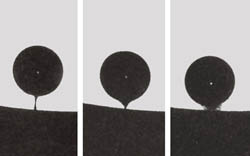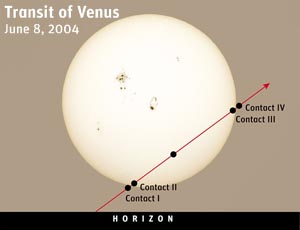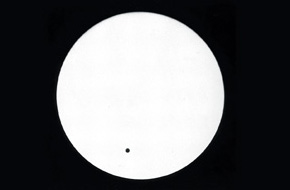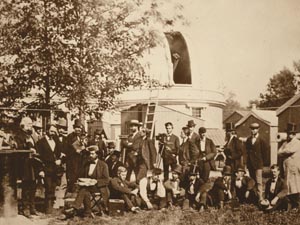May 24, 2004
Contacts:
J. Kelly Beatty, Executive Editor
855-638-5388 x143, [email protected]
Alan MacRobert, Senior Editor
855-638-5388 x151, [email protected]
Note to Editors/Producers: This release is accompanied by high-quality illustrations and a broacast-quality animation; see details below.
To provide your viewers and readers with more background on the transit, please direct them to http://SkyandTelescope.com/transit.
On Tuesday, June 8th, the planet Venus will glide directly across the face of the Sun. No one alive today has seen Venus "transit" the Sun — it last happened in 1882 — and astronomers around the world are eagerly awaiting this rare event. Only one other transit of Venus will occur this century, eight years from now on June 6, 2012.

Australian watchmaker F. Allerding recorded the “black-drop” effect as the silhouette of Venus prepared to exit the Sun’s disk on December 9, 1874.
Courtesy Institute for Astronomy, University of Vienna.
Think of a transit as a miniature eclipse of the Sun. During a total solar eclipse, the Moon completely blocks the Sun's disk for just a few minutes. But even though Venus is much larger than the Moon, it's also about 100 times farther away, so it can cover only a fraction of the solar disk. As Venus makes its long-awaited crossing, it will appear as a perfectly round black dot slowly moving across the Sun's face. The most interesting aspects of this 6-hour-long event will occur when Venus enters and exits the outer edge of the solar disk, each passage taking about 20 minutes to complete. For example, as it starts to leave the Sun the planet's silhouette may look pear-shaped, creating what's called the "black-drop effect."
For observers in eastern and central North America, the Sun rises on June 8th with the transit already well under way. The entire event will be visible from Europe, central/eastern Africa, the Middle East, and Asia (except the Far East). The table below lists representative North American cities for which the transit will be in progress at sunrise, grouped by time zone. Transit times for cities in Europe, Africa, the Middle East, and Asia are also available.
| Local Times for June 8th's Transit of Venus | ||||
| City | Sunrise | Venus's exit begins |
Venus's exit ends |
Sun's altitude |
| Halifax, NS | 5:29 a.m. | 8:05 a.m. | 8:25 a.m. | 28° |
| Moncton, NB | 5:28 a.m. | 8:05 a.m. | 8:25 a.m. | 28° |
| Saint John’s, NL | 5:06 a.m. | 8:35 a.m. | 8:55 a.m. | 35° |
| San Juan, PR | 6:47 a.m. | 8:08 a.m. | 8:28 a.m. | 22° |
| Atlanta, GA | 6:27 a.m. | 7:06 a.m. | 7:26 a.m. | 10° |
| Boston, MA | 5:08 a.m. | 7:05 a.m. | 7:25 a.m. | 23° |
| Charlotte, NC | 6:09 a.m. | 7:06 a.m. | 7:26 a.m. | 14° |
| Columbus, OH | 6:03 a.m. | 7:05 a.m. | 7:25 a.m. | 13° |
| Detroit, MI | 5:56 a.m. | 7:05 a.m. | 7:25 a.m. | 14° |
| Miami, FL | 6:29 a.m. | 7:07 a.m. | 7:27 a.m. | 11° |
| Montreal, QC | 5:06 a.m. | 7:05 a.m. | 7:25 a.m. | 22° |
| New York, NY | 5:25 a.m. | 7:05 a.m. | 7:25 a.m. | 20° |
| Ottawa, ON | 5:15 a.m. | 7:05 a.m. | 7:25 a.m. | 20° |
| Pittsburgh, PA | 5:50 a.m. | 7:05 a.m. | 7:25 a.m. | 16° |
| Toronto, ON | 5:36 a.m. | 7:05 a.m. | 7:25 a.m. | 17° |
| Washington, DC | 5:43 a.m. | 7:06 a.m. | 7:26 a.m. | 18° |
| Chicago, IL | 5:16 a.m. | 6:05 a.m. | 6:25 a.m. | 11° |
| Dallas, TX | 6:18 a.m. | — | 6:26 a.m. | 1° |
| Little Rock, AR | 5:56 a.m. | 6:05 a.m. | 6:25 a.m. | 5° |
| Memphis, TN | 5:46 a.m. | 6:05 a.m. | 6:26 a.m. | 7° |
| Minneapolis, MN | 5:27 a.m. | 6:04 a.m. | 6:24 a.m. | 8° |
| Omaha, NE | 5:51 a.m. | 6:04 a.m. | 6:25 a.m. | 5° |
| New Orleans, LA | 5:59 a.m. | 6:06 a.m. | 6:26 a.m. | 5° |
| St. Louis, MO | 5:36 a.m. | 6:05 a.m. | 6:25 a.m. | 8° |
| Sioux Falls, SD | 5:46 a.m. | 6:04 a.m. | 6:25 a.m. | 5° |
| Winnipeg, MB | 5:21 a.m. | 6:03 a.m. | 6:24 a.m. | 8° |
| Edmonton, AB | 5:07 a.m. | — | 5:23 a.m. | 1° |
| Regina, SK | 4:48 a.m. | 5:03 a.m. | 5:23 a.m. | 4° |
Warning: The Sun is dangerous to look at directly without a safe solar filter. Staring at it can cause serious eye injury and even blindness.
Fortunately, there are many easy ways to watch the transit safely. If you have keen vision, Venus should appear just large enough to be barely visible as a tiny black dot as it crosses the Sun. But when looking at the Sun you must use a safe solar filter, such as a #13 or #14 welder's glass or special "eclipse glasses" designed for solar viewing. Filters that are not safe, though sometimes recommended in error, include smoked glass, stacked sunglasses, metallized candy wrappers, and compact discs. While these will darken the Sun, they may still transmit enough invisible infrared radiation to damage your eyes.
Binoculars or telescopes can be used to view the transit, even if they are not equipped with a safe solar filter. Do not look directly into the eyepiece or the telescope's finder, but instead place a white card behind the eyepiece and project the Sun's image onto it. (The small, dark-glass disks that screw into the eyepieces of some older scopes are not safe and should be discarded. The Sun's light and heat, concentrated by the telescope, may shatter them suddenly.)
A guide to June's transit of Venus and viewing the Sun safely appears in the May/June issue of Night Sky magazine, now available on newsstands. To obtain a PDF of this article via e-mail, media representatives should contact Marcy L. Dill (855-638-5388 x143; [email protected]). More detailed articles, exploring the historical significance of transits and how to photograph them, appear in the February, May, and June issues of Sky & Telescope magazine.
For more tips on how to view the Sun safely, see "Safe Solar Observing".
Sky & Telescope is making the following six illustrations and an animation available to the news media. Permission is granted for one-time, nonexclusive use in print and broadcast media, as long as appropriate credits (as noted in each caption) are included. Web publication must include a link to SkyandTelescope.com.

When the Sun rises over North America on June 8th, the transit of Venus will already be more than half over. But skywatchers across the continent's eastern half will still be able to watch the planet's exit. Contact III denotes when the silhouette of Venus just touches the Sun's outer edge; about 20 minutes later, at Contact IV, Venus will be completely off the Sun. During its crossing Venus will look like a sharp, black circle. By contrast, sunspots look dark but usually have irregular shapes and less-distinct edges. Click on the image to download a publication-quality version (131-kilobyte JPEG) by anonymous FTP.
Sky & Telescope illustration.

Observers in the eastern two-thirds of North America will have only a short time to catch the transit of Venus. This map shows the time remaining after local sunrise until Venus has completely exited the Sun's disk. Click on the image to download a publication-quality version (127-kilobyte GIF) by anonymous FTP.
Sky & Telescope illustration.

The entire transit of Venus is visible from Europe, Africa, the Middle East, and most of Asia. This publication-quality map is available via anonymous FTP both with labels (92-kilobyte GIF) and without labels (96-kilobyte GIF).
Sky & Telescope illustration.

Students at Vassar College, New York, acquired this image of the transit of Venus on December 6, 1882.
Courtesy Vassar College.

Australian watchmaker F. Allerding recorded the “black-drop” effect as the silhouette of Venus prepared to exit the Sun’s disk on December 9, 1874. Adapted from Observations of the Transit of Venus Made in New South Wales by Henry C. Russell (Sydney, 1892).
Courtesy Institute for Astronomy, University of Vienna.

Astronomers gather at the U.S. Naval Observatory in Washington, D.C., in preparation for the American expeditions to the 1874 transit of Venus. Click on the image to download a publication-quality version (599-kilobyte JPEG) by anonymous FTP.
Courtesy U.S. Naval Observatory Library.

The December 6, 1882, transit of Venus was already under way when the Sun rose over Lick Observatory in California and David Peck Todd began photographing the planet's march across the solar disk. Todd's 147 surviving photos, of which these are numbered 11, 88, and 151 (left to right), have been turned into a movie by astronomers Tony Misch and Bill Sheehan, as explained in the accompanying article "Reanimating the 1882 Transit of Venus". You can download QuickTime versions in two sizes: 640 x 480 pixels (4.0 megabytes) or 320 x 240 pixels (1.2 megabytes).
© 2003 University of California Observatories / Lick Observatory; courtesy Sky & Telescope.
 0
0
Comments
You must be logged in to post a comment.